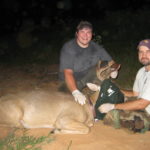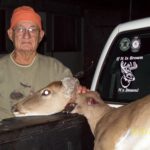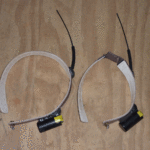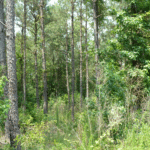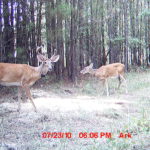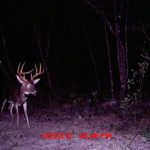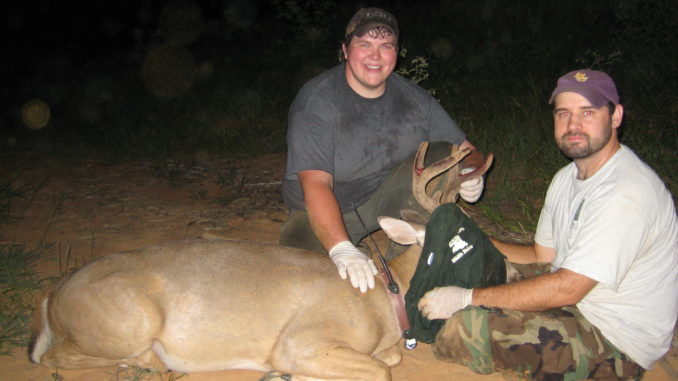
A recent deer telemetry study in this North Louisiana parish revealed some fascinating information about the habits of bucks and does.
Union Parish is over 561,000 acres in size and is 85 percent forested. For the past three years, it has ranked first in total whitetail harvest, according to the statewide reporting system.
In January 2009, researchers began to trap and radio-collar deer in Union Parish to provide basic habitat selection, home-range size and survival estimates. The LDWF/LSU joint research project took place on two adjacent established hunting clubs, Buffalo Hole and Ten Mile Creek, in a pine-dominant landscape primarily owned by Plum Creek. The land is intensively managed for maximum wood fiber production, and is representative of the industrial pine land in Northwest Louisiana. After establishment, pine plantations are thinned once or twice before being clear cut, usually no later than 25 years old.
This region is classified as moderate in deer productivity, and ranks second only to the bottomland and upland hardwood physiographic regions of the state. The 10-year mean harvest rate for the study area is about 1 deer per 50 acres. Hunters harvest male and female deer almost evenly, and the herd is maintained at or below carrying capacity. There are no antler restrictions, members are allowed the state limit and hunting deer over bait is very common, as it is all over the state.
A total of 61 deer were captured and received numbered ear tags. Of those, 47 (1.5 years old or older) received a VHF radio-collar that was used to track movements. Home range and core-area estimates were determined for 23 males and 24 females through radio telemetry.
The amount of space used by deer was lower (Table 1) than expected considering available natural food resources and results from previous literature, but was not as small as previously observed in the bottomland telemetry study, which were the lowest published in recent scientific literature (Thayer 2009). Seasons were determined based on biological and environmental cues (fawning, breeding) and the hunting season on the study area (Oct. 1–Jan. 31).
Male movement and home range
Male space use varied seasonally, with the largest average home range occurring in late winter through spring. During this period, baiting is drastically reduced with the end of hunting season, and food resources are initially scarce with low browse and reduced mast availability.
Home ranges increased as males traveled further, likely to find food and to replenish fat reserves lost during the rut.
As late winter becomes spring, browse increases where sunlight can reach the ground and forest management practices allow plant abundance and diversity. Young male (1.5-year-olds) dispersal occurred during this period with one individual traveling 7.6 miles. Sample sizes were not large enough to allow statistical analyses for young vs. adult males, but most adult-male home ranges were smaller.
Home ranges of male deer decreased to their lowest during the summer period. During this period, temperatures soar, and initially, browse resources are at their highest. Long movements are not necessary to find food, and more sedentary behavior is metabolically beneficial.
As the summer wears on, nutrient levels of deer browse plants become reduced as plants become more lignified and new growth drops off. Antler growth is peaking during this period, and males are often found in bachelor groups.
During fall to mid winter, browse resources have declined, mast resources normally become available and deer enter the breeding period. During much of this period, seeking food is not the priority for males.
On the study site, herd health data indicated most females bred from mid November to early December. However, male deer have the ability and desire to breed as soon as their velvet is shed until their antlers drop. So during this entire period, male movement is influenced by this underlying biological urge.
Female movement and home range
For females, home-range size was not statistically different by season. Home ranges of females were generally smaller than males, except during summer. Females are carrying fawns during the spring and summer, and have high nutrient demands for fetal development. The last trimester prior to fawning is the most critical and when energy demands are highest during gestation.
Once fawns are born, the nutritional demands of milk production are even higher. Most fawns on the study site are born in June, so the entire summer period is a critical time for adult females, requiring high quality and abundant food resources for good productivity and recruitment.
Females will travel fairly long distances when necessary. Readers may remember the flood events in the upper Ouachita basin during the fall and winter of 2009. One adult female in a flooded area in the study traveled 1.5 miles one day to escape flood waters, and returned to her home range two weeks later. She then again traveled another 1.25 miles away from the flood, and only returned after the water had completely receded.
In spring 2010 a 4-year-old doe traveled 4.2 miles from her capture site and documented home range for unknown reasons.
Habitat selection
The study site consisted of more than 9,500 total acres encompassing six defined habitat types (Table 2). Pine stands 0-4 years old included areas that had been clear cut and new plantations. Depending on whether an herbicide application had been applied or not determined browse availability and cover levels in these habitats.
Pine stands aged 5-12 years old were the most abundant habitat available, and likely had the least amount of browse due to canopy closure.
Pine stands 13-19 years old were the least abundant habitat available, and had been thinned at least once. This habitat along with pine stands >20 years old likely had the most browse available. Hardwood areas were typically riparian and stream side zones, important for shade, water and hard mast sources. Openings were food plots, logging sets, well sites, pipelines and roadways.
When selecting home ranges, both males and females favored hardwoods and forest openings compared to other habitats available across the study site. Hunters often used forest openings for bait sites to hunt over. Openings also are associated with “edge,” where sunlight increases herbaceous growth against the wood line. Hardwoods offer mast, plant diversity, shade and water.
Females also selected 0- to 4-year-old pines, likely for the good browse availability and cover provided for young fawns.
At smaller spatial scales, “core areas” are where deer spend most of their time within their home ranges. In summer, males again selected hardwood areas, but also spent a lot of time in 5- to 12-year-old pine, the dominant habitat type across the landscape.
Females selected 13- to 19-year-old pines. In fall, both males and females selected 0-4 and 13-19 year old pines. These two pine habitats likely had some of the most abundant browse and cover availability. In fall, hunting pressure plays an important role in where deer may go to find escape cover.
Survival and mortality
Survival did not differ statistically for males and females. Average annual survival was 51 percent. Fall survival was 54 percent, while spring and summer survival was over 95 percent.
Hunting was the primary cause of mortality in the study. Of the 23 collared males, 12 (52 percent) were harvested by hunters. Three (13 percent) male deer died from unknown causes.
Of the 24 collared females 10 (42 percent) were harvested by hunters, and three (13 percent) died from unknown causes. Unknown causes of deaths occurred primarily in the spring and summer, and likely were related to hemorrhagic or some other disease. Carcasses were quickly scavenged, making the determination of cause of death difficult. It is possible that predation occurred on some individuals, but this was not determined from the study. There were no known vehicle collisions on this rural study site.
At the conclusion of the study, 14 deer were still carrying functioning radio collars.
Distances from trap site to harvest locations ranged from only a few hundred yards for a 1.5-year-old female to 7.6 miles for a 1.5-year-old male. Twenty of 22 radio-collared (91 percent) deer were harvested over bait during this study.
Conclusions
Whitetail hunters in Union Parish pine-dominant habitats have enjoyed high hunting success for decades. Balanced either-sex harvest strategies have helped maintain deer herds in balance with the habitat and allowed maximum sustainable yield.
Feeding deer and hunting deer over bait are widespread and common practices for Louisiana hunters, including hunters on both telemetry studies recently completed. Home-range sizes in our studies have been smaller than expected and some of the smallest in the published scientific literature. Feeding and bating likely contributed to these small home-range sizes.
Although baiting may increase harvest opportunities, and especially the harvest of young deer, the long-term effects may not be fully known yet. The two radio-collared animals not harvested over bait were 4.5-year-old bucks who were seen chasing females at the time of harvest.
Smaller home-range sizes may reduce resources for deer when feed is no longer available and increase predator encounters near the bait sites. In recent years, fawn predation has become more of a concern to deer managers in the Southeast. Feral hog competition for resources is also a concern. Hunters who feed or bait deer should install exclusion fencing around any feeders they use.
Harvest rates of 40 percent or higher depend on maximum productivity and recruitment of fawns into the preseason population. Future harvest rates will continue to be determined by environmental factors and the resulting habitat quality. Forest management practices, rainfall amounts and timing, soil fertility, plant abundance and diversity are all important contributing factors.
AUTHORS’ NOTE: We thank Plum Creek for access and their cooperation, LDWF, LSU, and the LSU Ag Center. We thank the Buffalo Hole and Ten Mile Creek hunting clubs, hunters and other LDWF employees who helped make the project successful. The authors would like to express their appreciation to retired LDWF deer biologist Larry Savage. This project originated with him. His career work with the Deer Management Assistance Program around the state and especially in North Louisiana and the delta region helped lay the foundation for “quality deer management.”
